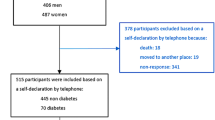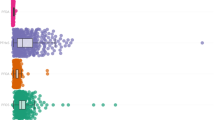Abstract
The aim of this study was to reveal whether accumulation of the persistent organic pollutants (POPs), especially polychlorinated biphenyl (2,2′,4,4′,5,5′-hexachlorobiphenyl, PCB 153), affects plasma levels of adiponectin in obese patients. The study was designed as a longitudinal intervention trial with a control group, where 27 obese women (body mass index (BMI)>30 kg/m2; age 21–74 years) were studied before (OB) and after (OB-LCD) a 3-month low-calorie-diet intervention (LCD; 5 MJ daily). As the control group, 9 female volunteers without LCD intervention were used (C; BMI=19–25 kg/m2; age 21–64 years). Plasma levels of PCB 153 were measured by high-resolution gas chromatography with electron capture detection; total adiponectin and insulin plasma levels were quantified by immunoassays; and adiponectin multimeric complexes were quantified by immunoblotting. Plasma levels of total adiponectin, high and medium molecular weight multimers significantly negatively correlated with plasma levels of PCB 153 in OB, but not in C or in OB-LCD, whereas the LCD intervention lowered BMI by 3.3±3.0 kg/m2. Our results may suggest suppression of adiponectin by PCB 153 in obese women under non-energy-restrictive regime, which may contribute to the known association of PCB 153 and other POPs with type 2 diabetes.
This is a preview of subscription content, access via your institution
Access options
Subscribe to this journal
Receive 12 print issues and online access
$259.00 per year
only $21.58 per issue
Buy this article
- Purchase on Springer Link
- Instant access to full article PDF
Prices may be subject to local taxes which are calculated during checkout

Similar content being viewed by others
References
Rignell-Hydbom A, Rylander L, Hagmar L . Exposure to persistent organochlorine pollutants and type 2 diabetes mellitus. Hum Exp Toxicol 2007; 26: 447–452.
Rylander L, Rignell-Hydbom A, Hagmar L . A cross-sectional study of the association between persistent organochlorine pollutants and diabetes. Environ Health 2005; 4: 28.
Verner MA, Charbonneau M, López-Carrilo L, Haddad S . Physiologically based pharmacokinetic modeling of persistent organic pollutants for lifetime exposure assessment: a new tool in breast cancer epidemiologic studies. Environ Health Perspect 2008; 116: 886–892.
Mullerova D, Kopecky J . White adipose tissue: storage and effector site for environmental pollutants. Physiol Res 2007; 56: 375–381.
Rondinone CM . Adipocyte-derived hormones, cytokines, and mediators. Endocrine 2006; 29: 81–90.
Vogel CF, Nishimura N, Sciullo E, Wong P, Li W, Matsumura F . Modulation of the chemokines KC and MCP-1 by 2,3,7,8-tetrachlorodibenzo-p-dioxin (TCDD) in mice. Arch Biochem Biophys 2007; 461: 169–175.
Arita Y, Kihara S, Ouchi N, Takahashi M, Maeda K, Miyagawa J et al. Paradoxical decrease of an adipose-specific protein, adiponectin, in obesity. Biochem Biophys Res 1999; 257: 79–83.
Abbasi F, Chu JW, Lamendola C, McLaughlin T, Hayden J, Reaven GM et al. Discrimination between obesity and insulin resistance in the relationship with adiponectin. Diabetes 2004; 53: 585–590.
Hotta K, Funahashi T, Arita Y . Plasma concentration of a novel, adipose-specific protein, adiponectin, in type 2 diabetic patients. Arterioscler Thtomb Vasc Biol 2000; 20: 1595–1599.
Pajvani UB, Hawkins M, Combs TP, Rajala MW, Doebber T, Berger JP et al. Complex distribution, not absolute amount of adiponectin, correlates with thiazolidine-mediated improvement in insulin sensitivity. J Biol Chem 2004; 279: 12152–12162.
Polak J, Kovacova Z, Jacek M, Klimcakova E, Kovacikova M, Vitkova M et al. An increase in plasma adiponectin multimeric complexes follows hypocaloric diet-induced weight loss in obese and overweight pre-menopausal women. Clin Sci (Lond) 2007; 112: 557–565.
Karasek L, Hajslova J, Rosmus J, Huhnerfuss H . Methylsulfonyl PCB and DDE metabolites and their enantioselective gas chromatographic separation in human adipose tissues, seal blubber and pelican muscle. Chemosphere 2007; 67: S22–S27.
Kern PA, Said S, Jackson Jr WG, Michalek JE . Insulin sensitivity following agent orange exposure in Vietnam veterans with high blood levels of 2,3,7,8-tetrachlorodibenzo-p-dioxin. J Clin Endocrinol Metab 2004; 89: 4665–4672.
Arsenescu V, Arsenescu RI, King V, Swanson H, Cassis LA . Polychlorinated biphenyl 77 induces adipocyte differentiation and proinflammatory adipokines and promotes obesity and atherosclerosis. Environ Health Perspect 2008; 116: 761–768.
Schrader TJ, Cooke GM . Effects of Aroclors and individual PCB congeners on activation of the human androgen receptor in vitro. Reprod Toxicol 2003; 17: 15–23.
Yoshinari K, Sato T, Okino N, Sugatani J, Miwa M . Expression and induction of cytochromes P-450 in rat white adipose tissue. J Pharmacol Exp Ther 2004; 311: 147–154.
Woodcroft KJ, Novak RF . Insulin differentially affects xenobiotic-enhanced, cytochrome P-450 (CYP)2E1, CYP2B, CYP3A, and CYP4A expression in primary cultured rat hepatocytes. J Pharmacol Exp Ther 1999; 289: 1121–1127.
Yamazoe Y, Murayama N, Shimada M, Yamauchi K, Kato R . Cytochrome P450 in livers of diabetic rats: regulation by growth hormone and insulin. Arch Biochem Biophys 1989; 268: 567–575.
Li CC, Lii CK, Liu KL, Yang JJ, Chen HW . n-6 and n-3 polyunsaturated fatty acids down-regulate cytochrome P-450 2B1 gene expression induced by phenobarbital in primary rat hepatocytes. J Nutr Biochem 2006; 17: 707–715.
Flachs P, Mohamed-Ali V, Horakova O, Rossmeisl M, Hosseinzadeh-Attar MJ, Hensler M et al. Polyunsaturated fattyacids of marine origin induce adiponectin in mice fed a high-fat diet. Diabetology 2006; 49: 394–397.
Acknowledgements
This work is dedicated to Professor K Opatrny Jr, in memorial, for his personal support of this research. Supported by Grant MSM 0021620819 ‘Replacement of and support to some vital organs’ Charles University, Medical School and Teaching Hospital Plzen, Czech Republic.
Author information
Authors and Affiliations
Corresponding author
Rights and permissions
About this article
Cite this article
Mullerova, D., Kopecky, J., Matejkova, D. et al. Negative association between plasma levels of adiponectin and polychlorinated biphenyl 153 in obese women under non-energy-restrictive regime. Int J Obes 32, 1875–1878 (2008). https://doi.org/10.1038/ijo.2008.169
Received:
Revised:
Accepted:
Published:
Issue Date:
DOI: https://doi.org/10.1038/ijo.2008.169
Keywords
This article is cited by
-
Estimated dietary iodine intake as a predictor of placental size: evidence from the ELSPAC study
Nutrition & Metabolism (2018)
-
Trends in gene expression changes during adipogenesis in human adipose derived mesenchymal stem cells under dichlorodiphenyldichloroethylene exposure
Molecular & Cellular Toxicology (2018)
-
Polychlorinated biphenyls and links to cardiovascular disease
Environmental Science and Pollution Research (2016)
-
Association between serum levels of adiponectin and polychlorinated biphenyls in Korean men and women
Endocrine (2015)
-
Adiposity, body composition, and weight change in relation to organochlorine pollutant plasma concentrations
Journal of Exposure Science & Environmental Epidemiology (2012)



